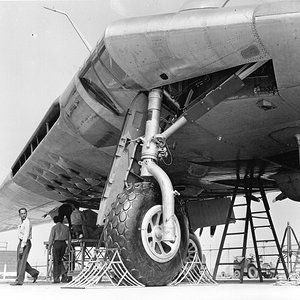Navigation
Install the app
How to install the app on iOS
Follow along with the video below to see how to install our site as a web app on your home screen.
Note: This feature may not be available in some browsers.
More options
You are using an out of date browser. It may not display this or other websites correctly.
You should upgrade or use an alternative browser.
You should upgrade or use an alternative browser.
ollowing tests of the Atar Volant, which have proved the ability of a vertically-mounted turbojet to raise a VTOL aircraft safely from the ground, of accelerating it in vertical flight to a speed where it can become airborne like a conventional aircraft, and of returning it to the ground in a vertical descent, SNECMA built a prototype research aircraft around this type of power plant. The actual power-unit used was the Atar 101 E.5V fitted with jet deflection nozzle and rated at 3,700kg of thrust.
Known as the C.450-01 Coleoptere, this prototype was basically similar to the C.400 P.3 Atar Volant, with tilting seat inside an enclosed cockpit, but was fitted with an annular wing to permit transition into horizontal flight. The airframe was built by the Nord company in its Chatillon-sous-Bagneux works. Directional control at take-off and landing was by pneumatic deflection of the main jet efflux, directional control during normal horizontal flight was by four swivelling fins equally spaced around the rear end of the annular wing, while transitions from vertical to horizontal attitudes were eased by the use of two small retractable fins mounted on the sides of the fuselage nose.
The C.450-01 made its first free vertical flight on May 6, 1959 at Melun-Villaroche. On July 25, during transition from vertical to horizontal flight control was lost at an altitude of about 75m and the Coleoptere crashed and was destroyed. The pilot, Auguste Morel, ejected successfully and was unhurt.
It was stated afterwards that the accident occurred when the intended programme of flight tests concerning inclination had been carried out successfully, and that neither the jet control stabilisation system nor the annular wing aerodynamic formula was the cause of the crash.
WINGS - Annular wing of light alloy construction, comprising two skins and internal structure. Chord 3.0m.
FUSELAGE - Conventional light alloy structure. Retractable fore-planes on nose.
TAIL UNIT - Cruciform fins and rudders of light alloy construction, mounted on trailing-edge of wing, to provide directional control in all axes.
LANDING GEAR - Four oleo-pneumatic legs mounted on trailing-edge of wing. Small castering wheels with rubber tyres. Wheel track 2.95m.
POWER PLANT - One SNECMA Atar 101E.V turbojet (3,700kg of thrust) mounted aft of cockpit in fuselage. Integral fuel tanks with total capacity of 700kg of fuel.
ACCOMMODATION - Pilot on tilting ejection seat in enclosed cabin.
Known as the C.450-01 Coleoptere, this prototype was basically similar to the C.400 P.3 Atar Volant, with tilting seat inside an enclosed cockpit, but was fitted with an annular wing to permit transition into horizontal flight. The airframe was built by the Nord company in its Chatillon-sous-Bagneux works. Directional control at take-off and landing was by pneumatic deflection of the main jet efflux, directional control during normal horizontal flight was by four swivelling fins equally spaced around the rear end of the annular wing, while transitions from vertical to horizontal attitudes were eased by the use of two small retractable fins mounted on the sides of the fuselage nose.
The C.450-01 made its first free vertical flight on May 6, 1959 at Melun-Villaroche. On July 25, during transition from vertical to horizontal flight control was lost at an altitude of about 75m and the Coleoptere crashed and was destroyed. The pilot, Auguste Morel, ejected successfully and was unhurt.
It was stated afterwards that the accident occurred when the intended programme of flight tests concerning inclination had been carried out successfully, and that neither the jet control stabilisation system nor the annular wing aerodynamic formula was the cause of the crash.
WINGS - Annular wing of light alloy construction, comprising two skins and internal structure. Chord 3.0m.
FUSELAGE - Conventional light alloy structure. Retractable fore-planes on nose.
TAIL UNIT - Cruciform fins and rudders of light alloy construction, mounted on trailing-edge of wing, to provide directional control in all axes.
LANDING GEAR - Four oleo-pneumatic legs mounted on trailing-edge of wing. Small castering wheels with rubber tyres. Wheel track 2.95m.
POWER PLANT - One SNECMA Atar 101E.V turbojet (3,700kg of thrust) mounted aft of cockpit in fuselage. Integral fuel tanks with total capacity of 700kg of fuel.
ACCOMMODATION - Pilot on tilting ejection seat in enclosed cabin.








